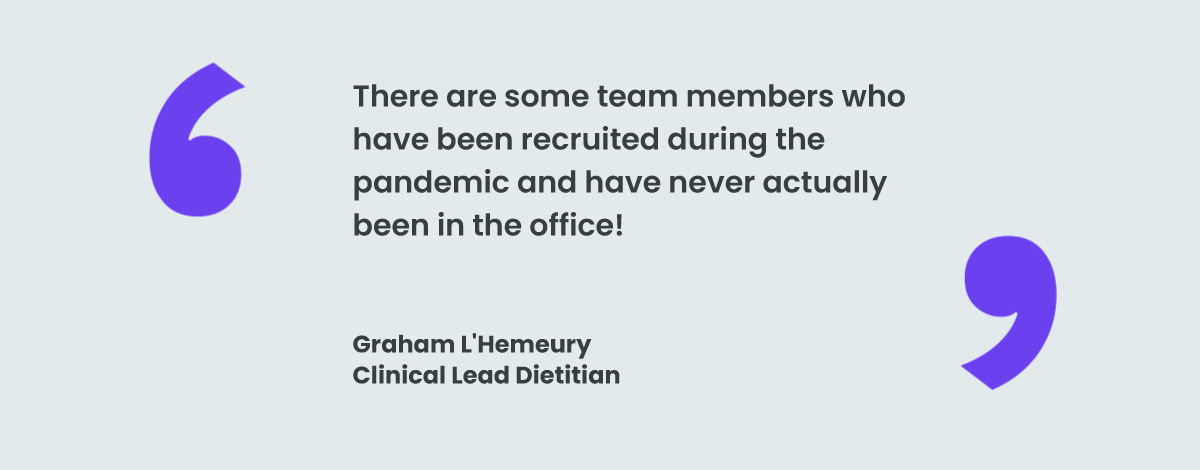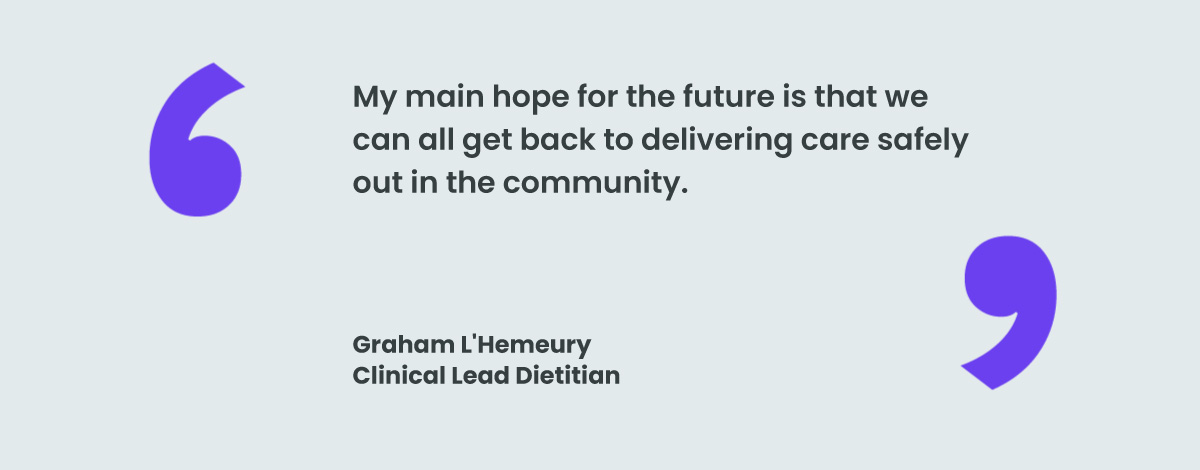Reflections with Julia: 'My hope for the future is that we can all get back to delivering care safely out in the community'
10 Jun 2021Interview
In this interview, we speak to Graham L'Hemeury, a Band 7 Clinical Lead Dietitian. The changes his team has experienced due to COVID will undoubtedly resonate with dietitians across the UK.
Graham joined the profession having retrained and qualified five years ago. Pre-lockdown, he had a full community caseload, working in clinics, patients' homes and occasionally nursing homes. He specialises in nutrition support and enteral feeding tubes in patients experiencing either neurological or mechanical problems with their swallowing.

Julia: What changed for you when the pandemic hit?
Graham: “All face to face interactions with patients stopped and were replaced by telephone calls and, later, video conferencing. We were only able to treat acute patients at that time, many of whom were being referred to us from the hospital, which was unable to see them. For example, patients who had been due to go into hospital for feeding tubes to be inserted had those appointments cancelled. We, therefore, needed to come up with other ways to support them for the time being.
“At first, we were all required to work from home, only later being able to slowly return to the office where possible.”
What were the biggest challenges you faced?
Workforce capacity
“At the start, we didn’t have the technological infrastructure in place to all work at home effectively - no doubt there were plans to do things more virtually in the future, but nothing was in place yet. We slowly got up and running on Teams and had secure networks installed, which made things much easier. Then, eventually, those who could go back to the office were able to do so, albeit wearing masks and social distancing (which is not always easy!).
“Some staff still needed to shield, however, and some had to self-isolate at various times - made worse by them not being able to get hold of COVID tests. This resulted in a lot of reshuffling of schedules.
“Some staff were also being deployed into the hospital wards, where they were seeing a greater level of staff absence. For example, our team focusing on oncology patients were deployed to provide care on the wards, so we had to take on their caseloads.”
Phone call limitations
“There is also the ongoing challenge of only being able to talk with some patients over the phone. Some don’t have a wifi connection and others are still nervous about receiving a home visit. Because we can’t actually see how patients look, if they tell us they’re doing OK, we have to take their word for it.”
Lack of informal communication
“There are some team members who have been recruited during the pandemic and have never actually been in the office! It’s tough not having that in-person support, just being able to stick your head in the office and check they’re OK or have them shout a question across the room. So it’s been vital to have regular catch-ups with them.
“Although I had a community caseload, I used to be based in the Acute patient office in the hospital. I’ve hardly seen any of those co-workers during the pandemic and have missed how easy patient handovers could be when one of their patients was going back home and needed me to follow up.”

What has been most important to you during this time?
“Having a supportive team that’s always willing to help each other out. I’ve made sure to have regular phone calls with staff who are still working from home, and had more regular catch-ups with those in the office too. We have also received more communications from a senior level about what has been going on from a hospital point of view.”
How has technology helped and what changes will stick for the future?
Virtual can be good!
“Video conferencing is a definite bonus. We used to travel across the county to have meetings with colleagues, which now seems a waste of time and expenses. I think we could leapfrog between virtual and face-to-face going forward.
“There is still a case for seeing patients in person, but perhaps this might not need to be the case after their initial assessment. So again, perhaps a mixture of both would be good.
“Some patients have actually preferred the remote consultations as it has saved them time and the need to travel.”
Cross-team working
“We have multidisciplinary team meetings with colleagues from different departments coming together to discuss a patient's care. These have been easier to coordinate online, and have become more regular and vital as we haven’t been able to deliver all the elements of our service ourselves.
“We have also been delegating more tasks, such as asking nutrition nurses (who are still visiting patients) to take patients’ weights. I think this has been really effective and hope we can continue some of these ways of working in future.”
New procedures
“With delays in patients receiving enteral feeding tubes, we are now able to place nasogastric tubes instead to help them in the interim. Going forward, it means that patients are able to receive a temporary tube like this whilst waiting for their permanent one, helping to lessen their deterioration.”
Back to clinics
“We have recently been starting to filter our less urgent cases back in, with a lot of prioritisation based on who can now come to a clinic. As an extra complication, we are now seeing an increase in patients recovering from COVID. Their breathing problems and a reduction in muscle mass from being sedentary in a hospital bed is resulting in issues with their eating and weight. We are trying to squeeze in clinics specifically for these patients.
“My main hope for the future is that we can all get back to delivering care safely out in the community. Even if things can’t get back fully to the way they were, just reaching a place of better stability and without the risk of hospitals becoming overrun again would be great.”

How has your CPD changed?
“There has been a big shift to webinars, so they have helped me to do CPD still. Just last week, I attended one around Vitamin D and sun exposure in different places around the world. It’s just a shame that many of them fall in the evening, as it feels like extra work time.
“I have also been able to log on and watch Grand Rounds online, which feature a specialist talking on a given subject. These were previously done in person on the hospital wards and I was never around at the right time, so I’m pleased I can now catch them.
“Due to changes in staff availability, I have been doing more administrative and managerial tasks that I would have otherwise not been involved in, so this has really helped my development.”
A huge thank you to Graham for taking the time to reflect with us on his experience. If you enjoyed this article and found it a valuable insight into the life of a dietitian, please share it on Twitter.
Julia helps you record, reflect, and report on your CPD through our website and app.
It's an easy way for you to stay on top of your CPD. Sign up for a 14 day free today.